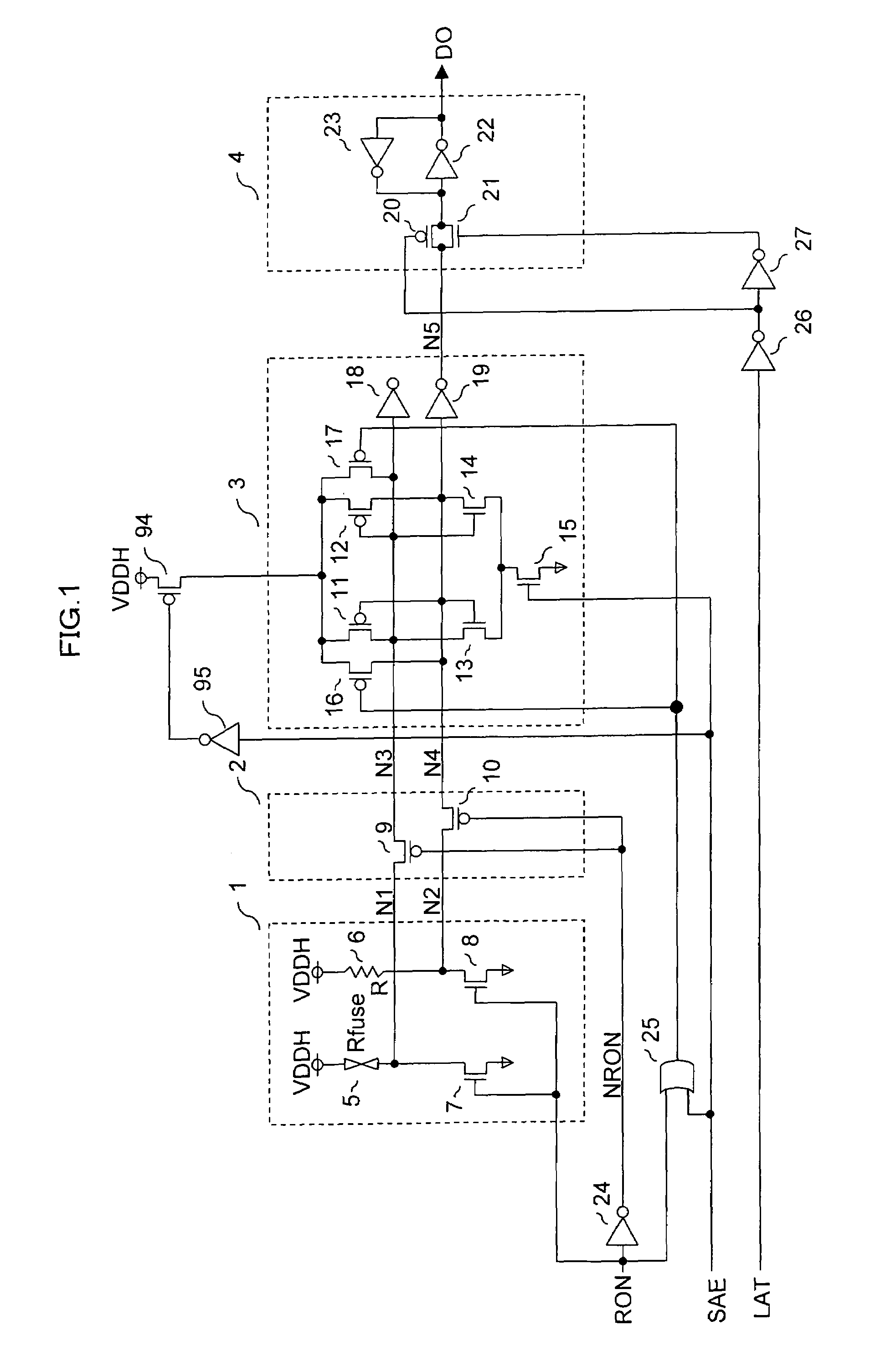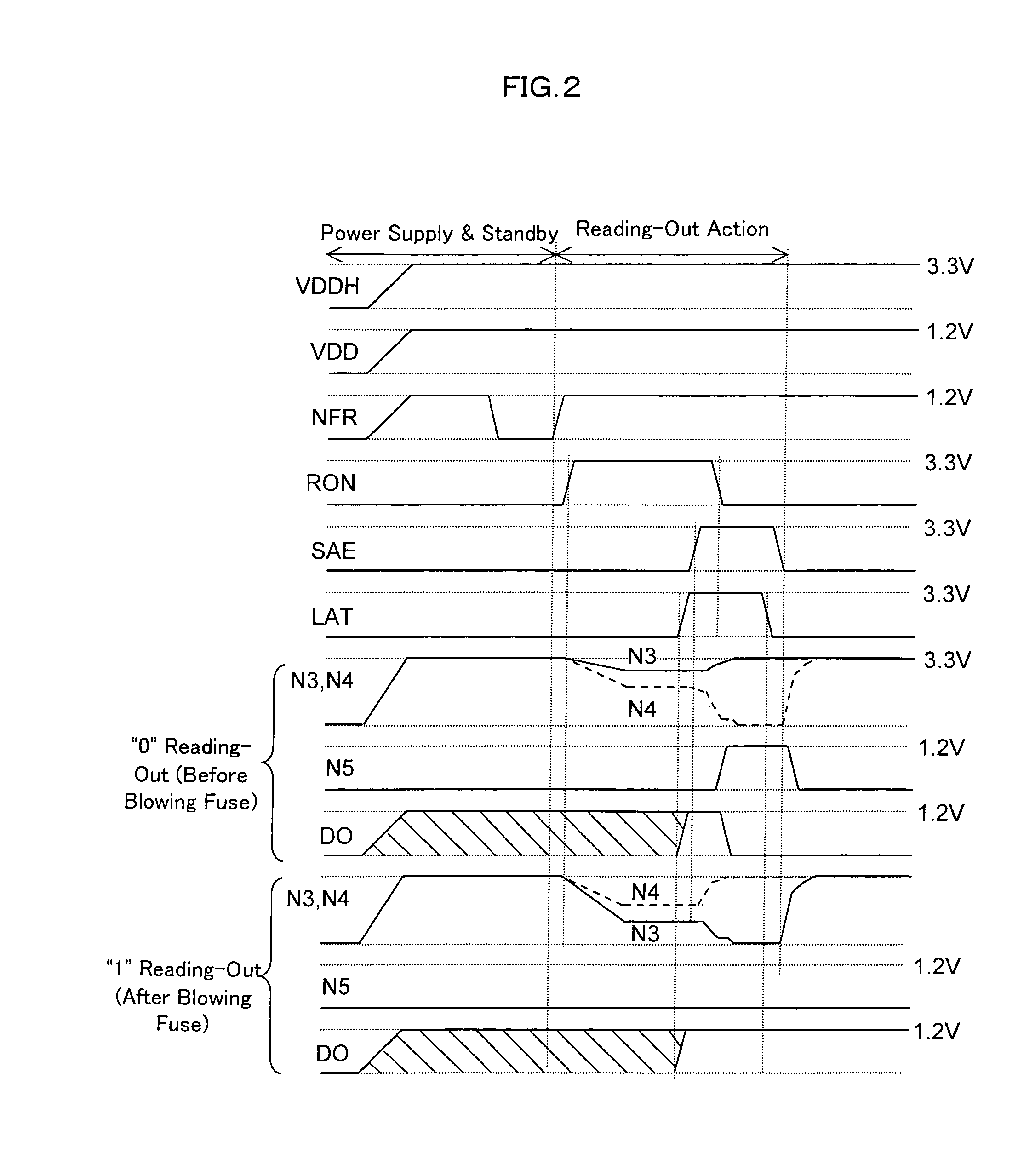Semiconductor memory
a technology of semiconductors and memory, applied in the field of semiconductor memory, can solve the problems of generating reading out failure, mis-latching data, and increasing the difficulty of fuses, and achieve the effect of improving the resistance of factors and improving reliability
- Summary
- Abstract
- Description
- Claims
- Application Information
AI Technical Summary
Benefits of technology
Problems solved by technology
Method used
Image
Examples
first embodiment
(First Embodiment)
[0044]FIG. 1 shows an example of a semiconductor memory which comprises an electric fuse. In FIG. 1, reference numeral 1 is a voltage converting circuit. 2 is a switch circuit. 3 is a voltage comparing circuit. 4 is a latch circuit. RON is a control signal formed with a one-shot pulse, which controls the voltage converting circuit 1, the switch circuit 2, and the voltage comparing circuit 3. SAE is a control signal formed with a one-shot pulse, which controls the voltage comparing circuit 3. LAT is a control signal formed with a one-shot pulse, which controls the latch circuit 4.
[0045]The voltage converting circuit 1 comprises an electric fuse (a first resistance element) 5, a reference resistance (a second resistance element) 6, and NMOS transistors (NMOS switches) 7, 8. One end each of both the electric fuse 5 and the reference resistance 6 is connected to a power source VDD and the other end thereof is connected to GND (ground potential) through the NMOS transis...
second embodiment
(Second Embodiment)
[0086]In the case where the latch gate of the first embodiment (FIG. 1) is constituted of a MOS transistor with a thin gate oxide film, the voltage level of the control signal becomes as follows. That is, the control signals RON, SAE have the voltage level which is boosted from the VDD to the VDDH according to the external input signal NFR (VDD level), whereas the control signal LAT becomes the voltage level of the VDD. However, under such voltage properties, if the voltage converting circuit 1 and the voltage comparing circuit 3 are controlled by the control signal RON, SAE of the VDDH level and the latch circuit 4 is controlled by the control signal LAT of the VDD level, there may cause a following inconvenience. Specifically, when the VDD is the low voltage and the VDDH is the high voltage, there may be a timing skew generated between the control signals RON, SAE of the VDDH level and the control signal LAT of the VDD level. Such timing skew will be described b...
third embodiment
(Third Embodiment)
[0089]There may be manufacture dispersions and blown-resistance dispersions generated in the initial resistance of the electric fuse 5 or the resistance value thereof after the blowout even if the electric fuse 5 is formed by using any selected types of materials. For example, in the semiconductor memory comprising the electric fuse 5, if the resistance value of the electric fuse 5 is the value with a smaller margin with respect to the reference resistance 6, the resistance value fluctuates when the electric fuse 5 is energized while being used as a product. Thus, a reading-out failure may be caused. Such failures happen even if, during the inspection, the “0” reading-out action and “1” reading-out action are normally carried out for the value of the reference resistance 6.
[0090]In order to avoid such failures in advance, the semiconductor memory of this embodiment comprises a circuit structure which checks the resistance value margins before and after the blowout ...
PUM
 Login to View More
Login to View More Abstract
Description
Claims
Application Information
 Login to View More
Login to View More - R&D Engineer
- R&D Manager
- IP Professional
- Industry Leading Data Capabilities
- Powerful AI technology
- Patent DNA Extraction
Browse by: Latest US Patents, China's latest patents, Technical Efficacy Thesaurus, Application Domain, Technology Topic, Popular Technical Reports.
© 2024 PatSnap. All rights reserved.Legal|Privacy policy|Modern Slavery Act Transparency Statement|Sitemap|About US| Contact US: help@patsnap.com










